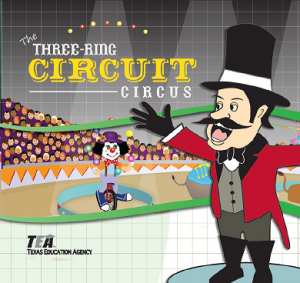Engage: Observations
Engage: Students observe different forms of energy in an energy ball.
Directions:
- Hold the energy ball for all students to observe. Do not display or touch the two metal strips at this time.
- Ask the following: What are some physical properties of the energy ball?
- Touch both metal strips and allow students to observe the flashing light and siren sound.
- Instruct students to discuss within their groups what they think is happening and why.
Facilitation Questions:
Why did the energy ball light up and make noise?
What forms of energy did you observe?
Explore: Exploring Energy
Instruct students to follow the directions on RM 1 - Exploring Energy. If you do not have the necessary materials to complete the activity, instruct students to use the virtual lab below. Ask students to record their observations.
Facilitation Questions:
Activity 1
How did you make the light bulb light up using the batteries as an energy source?
How did you make the light bulb light up using the generator?
Were there any differences between using the batteries and the generator in making the light bulb light up?
What forms of energy did you observe?
Activity 2
How did you make the buzzer produce sound using the batteries?
How did you make the buzzer produce sound using the generator?
Were there any differences between using the batteries and the generator to make the buzzer produce sound?
What forms of energy did you observe?
Activity 3
How did you make the motor run using the batteries?
How did you make the motor run using the generator?
Were there any differences between using the batteries and the generator to make the motor run?
What forms of energy did you observe?
Explain: Three-Ring Circuit Circus
Explain: Students explain how electricity flows through a circuit and how conductors and insulators interact with the circuit.
Activity:
Read and discuss The Three-Ring Circuit Circus. Instruct student pairs to take turns summarizing what they learned from the book.
Facilitation Questions:
What had to happen before the animals could perform?
What had to happen before the light bulb would light up, the buzzer would make noise, or the motor would run?
What is a circuit?
What happens when wires are not connected in a circuit?
What are open circuits also called?
What do you think happens when you turn a light off at home or school?
What happens when everything in a circuit is properly connected?
What are closed circuits also called?
What do you think happens when you turn the television on at home?
What are conductors?
What kinds of circuits are created when conductors are placed in them?
What are insulators?
What kinds of circuits are created when insulators are placed in them?
Elaborate: Conductors and Insulators
Elaborate: Students investigate conductors and insulators in a circuit.
Activity:
Instruct students to complete the virtual lab activity.
Facilitation Questions:
Which items caused the light bulb to light up?
What kind of circuit did these items create? How do you know?
What would you call the items that allowed the light bulb to light up? Why?
Which items did not allow the light bulb to light up?
What kind of circuit did these items create? How do you know?
What would you call the items that did not allow the light bulb to light up? Why?
Where else in your life do you use open and closed circuits?
Why do we need to be able to open and close circuits?
Science Notebook Entry:
Ask students to respond to the following prompt in their science notebooks:
- What is the difference between conductors and insulators and how do they affect circuits? What are some examples of conductors and insulators?
Differentiation Strategy: Provide the prompt below and a screwdriver (optional) to G/T students.
- Explain the design of a screwdriver. Be sure to use vocabulary words including circuit, conductor, and insulator.
Evaluate: Electrifying Energy
Evaluate: Students write a letter explaining how to build a working circuit.
Instruct students to use their knowledge of the forms of energy, electrical circuits, conductors, and insulators to complete Electrifying Energy Assessment below.
Electrifying Energy Assessment:
Write a letter to your best friend explaining how to put a circuit together. Your circuit must have an energy source, wires, and generate energy for a light bulb, buzzer, or motor. Make sure you include the following vocabulary words in your letter:
- open, incomplete, broken circuit
- closed, complete, working circuit
- sound energy
- light energy
- electrical energy
- mechanical energy
- heat/thermal energy
- conductor
- insulator
Your letter also needs to include a date, salutation, closing, and a labeled drawing of the setup.
Date __________________
Dear _______________________,
____________________________________________________________________________
____________________________________________________________________________
____________________________________________________________________________
____________________________________________________________________________
____________________________________________________________________________
Sincerely,
______________________


